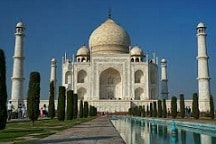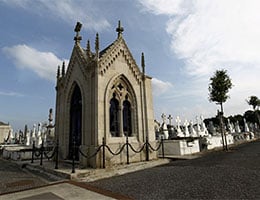 A mausoleum is a lavish tomb . The term comes from Mausolēum , a Latin word that referred to the tomb of Mausolus , who was monarch of Caria between the years 337 BC and 353 BC. c.
A mausoleum is a lavish tomb . The term comes from Mausolēum , a Latin word that referred to the tomb of Mausolus , who was monarch of Caria between the years 337 BC and 353 BC. c.
When Mausolus died, his wife, sister and successor Artemisia summoned great Greek sculptors and architects of the time to develop a funerary monument in his honor. Thus, Timoteo , Sátyro , Scopas , Pitheus , Leochares and other artists developed an impressive work of about 46 meters high and 134 meters in perimeter.
The Sepulcher of Mausoleion or Mausoleum of Halicarnassus has four floors that at the time displayed decorations in reliefs created by the important Greek sculptors mentioned in the previous paragraph. Such was its success on an aesthetic level that the Greek poet Antiparus of Sidon included it among the Seven Wonders of the Ancient World .
In addition to its beauty and imposing appearance, this mausoleum marked a before and after in the transition towards the monumental character of art, something that we can find in other works from the Hellenistic period, the fourth of Greek sculpture .
Since then, funeral monuments that pay tribute to a recognized or powerful personality have been called mausoleums. Many times, due to their characteristics, they are valued as great artistic manifestations and even become tourist attractions.
The Taj Mahal is one of the most famous mausoleums in the world . It is located in the Indian city of Agra and was built in the 17th century . Shah Jahan , Muslim emperor, was the one who ordered its construction in honor of his wife Mumtaz Mahal , who died giving birth to their fourteenth daughter.
Agra is located in the state of Uttar Pradesh , and the mausoleum was built next to the Yamuna River. It should be noted that it is a set of buildings with an imposing appearance, which is why it has achieved so much fame worldwide. According to some research, the work required more than twenty thousand workers led by many architects, who followed the orders of Ustad Ahmad Lahori , the court architect.
Among the known palaces, the Taj Mahal is considered the most beautiful in the world. In its style we can find elements typical of various architectures , such as Indian, Persian, Turkish and Islamic. Another of its characteristic features is the love with which it was designed, something that, although subjective, can be appreciated when observing and walking through it.
 Although the best-known part of the Taj Mahal is the mausoleum with a white marble dome, it consists of several walled buildings that reach seventeen hectares in area, where we can also find several gardens, a guest house and a mosque. great size.
Although the best-known part of the Taj Mahal is the mausoleum with a white marble dome, it consists of several walled buildings that reach seventeen hectares in area, where we can also find several gardens, a guest house and a mosque. great size.
In 1983, this monument was declared a World Heritage Site by UNESCO thanks to representing Indian Muslim art like no other and enjoying the admiration of people from all over the world. It is an essential part of the country's history, which currently attracts almost ten million tourists per year and is part of the list of The New Seven Wonders of the Modern World .
Lenin 's mausoleum, meanwhile, is one of the sites of interest in Moscow . There lie the embalmed remains of the communist leader Vladimir Ilyich Ulyanov , better known as Lenin , who died in 1924 . This mausoleum is located in Red Square in the Russian capital.
Another important mausoleum is that of Genghis Khan , in China . In this case, the particularity is that it does not house the body of the Mongol conqueror, since his whereabouts are unknown. The mausoleum was developed by the Chinese government between 1954 and 1956 .
